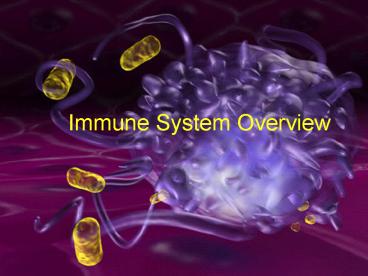Immune System Overview - PowerPoint PPT Presentation
1 / 33
Title:
Immune System Overview
Description:
ANATOMY OF THE IMMUNE SYSTEM The immune system is localized in several parts of the body immune cells develop in the primary organs - bone marrow and thymus immune ... – PowerPoint PPT presentation
Number of Views:398
Avg rating:3.0/5.0
Title: Immune System Overview
1
Immune System Overview
2
(No Transcript)
3
GOT DEFENSE?
4
ANATOMY OF THE IMMUNE SYSTEM
- The immune system is localized in several parts
of the body - immune cells develop in the primary organs - bone
marrow and thymus - immune responses occur in the secondary organs
5
(No Transcript)
6
(No Transcript)
7
IMMUNITY
Adaptive
Innate
Players
Humoral
Cell-Mediated
Players
Macrophages Granulocytes Natural killer
cells Complement Other chemicals
Antigen Presenting Cells T cells B
cells Antibodies
Characteristics
Characteristics
Action requires days to develop Response is
specific Prevents progression to disease
Response is enhanced on repeated exposure to
pathogen
Action is immediate minutes to hours Response
is nonspecific First line of defense against
invading pathogens Response is not enhanced on
repeated exposure to pathogen
8
Immune System Innate and Adaptive
9
Cytokines
- Soluble protein molecules used by cells of the
immune system to communicate. - Functions include
- Mediation of natural immunity
- Regulation of lymphocyte activation, growth, and
differentiation - Regulation of immune-mediated inflammation
- Stimulation of immature leukocyte growth and
differentiation - Interleukins (IL-2 IL-4), interferons (a,ß,?),
tumor necrosis factors (a and ß), and
transforming growth factor ß
10
Immune System Innate and Adaptive
11
2. The immune system consists of
- Anatomic barriers (Skin,mucous membranes)
- Physiological barriers (temperature, pH)
- Phagocytic Barriers (cells that eat invaders)
- Inflammatory barriers (redness, swelling, heat
and pain)
12
(No Transcript)
13
Neutrophil
Eosinophil
Basophil
14
Monocytes
Dendritic cell
15
Immune System Innate (phagocytosis)
- 1. Phagocytic cells Macrophage, Neutrophil, and
Dendritic cells. - 2. Phagocytosis serves two key functions
- Killing microbes
- Antigen (Ag) Presentation
16
(No Transcript)
17
GOT DEFENSE?
18
Immune System Innate (phagocytosis)
19
Opsonization
20
Immune System Innate
- Inflammation
- A hallmark of innate immunity
- Local accumulation of immune cells and
molecules against - microbes
- Function to eliminate infections but often
cause tissue - damage diseases
21
Inflammatory Response
22
Inflammation
23
Inflammatory Response
24
The immune system consists of
- Antigen specificity
- Diversity
- Immunological memory
- Self/nonself recognition
- Anatomic barriers (Skin,mucous membranes)
- Physological barriers (temperature, pH)
- Phagocytic Barriers (cells that eat invaders)
- Inflammatory barriers (redness, swelling, heat
and pain)
25
(No Transcript)
26
(No Transcript)
27
Adaptive Immunity
28
(No Transcript)
29
(No Transcript)
30
Major Histocompatibility Complex (MHC)
- Also known as Human Leukocyte Antigen (HLA)
- Membrane bound, not soluble
- Present processed protein antigens (peptides)
to naïve T cells - MHC I -gt produced by almost all nucleated cells,
present antigen to CD8 cytotoxic T lymphocytes
(CTL) - MHC II -gt produced by professional antigen
presenting cells, present antigen to CD4
lymphocytes (T helper cells)
31
(No Transcript)
32
T Cell Receptors (TCRs)
- Produced by T lymphocytes
- Are surface bound, not secreted
- Recognize processed peptide antigens presented
on MHC molecules - Heterodimer of aß or ?d chains
- Like antibodies, each chain has a variable and
constant region - Also undergo gene rearrangement prior to
expression
33
- The immune system has evolved to
- Protect against invading pathogens or
- foreign substances.
- Maintain tissue homeostasis.
- Meanwhile, microbes have evolved to
- survive in the host.































